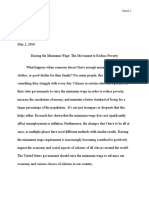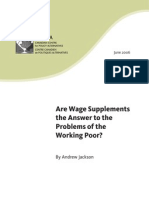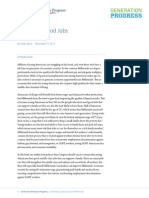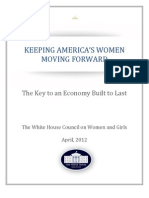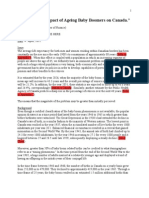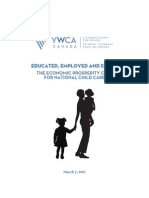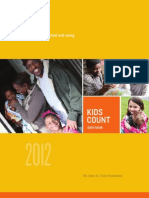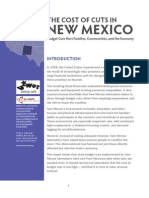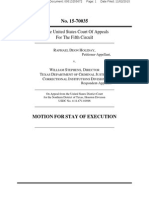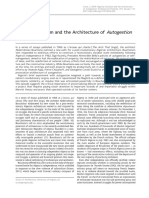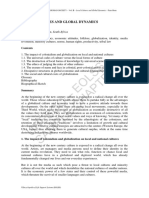Still Second Best Women's Poverty
Still Second Best Women's Poverty
Uploaded by
Thomas EdisonCopyright:
Available Formats
Still Second Best Women's Poverty
Still Second Best Women's Poverty
Uploaded by
Thomas EdisonOriginal Title
Copyright
Available Formats
Share this document
Did you find this document useful?
Is this content inappropriate?
Copyright:
Available Formats
Still Second Best Women's Poverty
Still Second Best Women's Poverty
Uploaded by
Thomas EdisonCopyright:
Available Formats
Still Second Best Women's Poverty
Written by: Amabel Davidson
Poverty affects women more than men; historically and up to these modern times. Even after emancipation, the Canada wide women's right to vote in 1940, the women's liberation movement and females now actively involved with the work force, women still remain poorer than men. Canada will be reviewed as a case in point.
Women historically and currently are more subject to poverty than men in Canada. Male poverty level income earners (13% of the population) numbered 1.9 million in 2001 while female poverty level income earners (16% of the population) numbered 2.4 million. Poverty is defined by low income cut off rates determined my Statistics Canada as individuals and families that spend more than 20% of their pretax income than the Canadian average for food, shelter and clothes. Low income before tax includes free market income and government transfers. After tax income is what the public views as disposable income, the money an individual can spend at will.1
Table 1 indicates that Canadian women full time workers on average earned 63% of males in 1978 with a gradual increase to 71% by 2008 in Canadian dollars.
Table 1 Average Earnings of Full-year, Full-time Earners (2008 constant dollars)2 Year 1978 1988 1998 2008 Males 54,400 53,800 56,300 62,600 34,400 35,100 40,500 44,700 Females 0.63 0.65 0.72 0.71 Ratio
Table 2 indicates that Canadian women full time workers by mean average assessment, earned 62% of males in 1978 with an gradual increase to 76% by 2008 in Canadian dollars..
Table 2 Median Earnings of Full-year, Full-time Workers (2008 constant dollars)3 Year 1978 1988 1998 2008 Males 50,600 49,700 49,000 50,600 31,200 32,100 36,300 38,600 Females 0.62 0.65 0.74 0.76 Ratio
2 3
Whether using average or median income statistics, it is clear that woman earn
approximately 28% less than me though the wage gap is narrowing. The reasons are discussed below.
The biggest factor affecting women's income is child rearing. Mothers are pregnant for 9 months and for much of that time are unable to work. After childbirth, women for the near term, stay with the child and out out of the labour market. Females are viewed as the primary caregivers of the young, often subjugating work to deal with child rearing, child illness or family emergency. Consequently woman are more likely to be viewed as part time workers compared to men who generally focus on employment as their primary responsibility.
As a comparison, in the Philippines where I am from, the women are more able to delegate child rearing to relatives as our families are extended with an acceptance of joint family care giving. Also the middle class can afford to hire a child minder/housekeeper as domestic help is cheap.
Workers who lack commitment to full time employment without interruption are naturally less likely to receive employer financed advanced training (increases jobs skills and wages) or advance to higher paying positions. Also, it is often impractical for employers to hold a position open for women during child rearing absences. For example, a when a trained secretary leaves for pregnancy, her position is likely filled by an unfamiliar/untrained substitute, making the company less efficient. Also, the temporary worker must be subsequently dismissed upon return of the full time worker. Note, that the substitute workier is likely female as well, being cast into the role temporary worker. Astute employers prefer workers who can consistently contribute to company productivity and advance their job
performance. As a further example, customers will not wait for product delivery til the pregnant female can return to work in a few months time. Females comprise 60% of minimum wage earners and 70% of part time employees.4 These poorly compensated positions often do not generate enough weeks to qualify for Employment Insurance (EI), company pension plans, Canada Pension, holiday/vacation pay, job security and advanced job skills. As an example, just 39% of unemployed women qualify for EI benefits compared to men at 45%.5
Domestic chores like housekeeping and child minding generate no income, advanced labour skills, EI or pensions.
Single parents, usually woman, are further handicapped. Many end up on welfare for 18 years until the children no longer qualifies for child subsidies. Upon reentering the workforce, the woman has no advanced skills, lost 18 years years of potential job security, has no EI or banked pension contributions. Also her job confidence has eroded by being out of the groove of the working life. Female lone-parent families have by far the lowest average total incomes among families in Canada. 6
Divorce and family breakup are more prevalent than any time in history. Both men and women lose out with family breakdown as combined resources are far superior to a single income. Yes, the men pay child support til the children are 18 but what are the women left with afterwards? Their youth, beauty, marketability and learning skills are on the ebb. The men remain active in the workplace all along; building skills, seniority, pay rates and pension
4 5 6
contributions.
Women live on average 3 years longer than men. Today women live 21 years after the age of 65. These are lower income pension years; another factor contributing to female poverty that is compounded by a lower pension contribution rate during youth. The lowest wage disparity between the sexes is upon entering the work force as youth. This widens substantially in old age as in 2001, 10% of senior men lived in poverty coma pared to a much higher percentage of woman at 21%.7
The income disparity between genders is slowly narrowing. A changing attitude where women expect and educate to be part of the work force are major factors. More woman are graduating high school and proceeding to college. As an example of female scholastic excellence: 75.3% The proportion of young women in Canada who received a high school diploma in 2006/2007. 67.6% The proportion of young men in Canada who received a high school diploma in 2006/2007.8 Improved education has allowed females to advance from the doldrums of the secretarial pool to higher responsibility and income; this is reflected by Table 1 and Table 2 income increases from 1978 through to 2008.
Women earn a higher participation rate in the professions than at any time in history with correspondingly higher incomes. Also some the stigma of male child rearing is easing, allowing more men to stay home to care for children, allowing the female partner to work. In this case, there is an income switch where the woman's earnings exceed the man's; certainly a reversal of fortune. The increased female incomes will accumulate through the years as the additional earnings now will translate into richer pensions in future. Thus the growing
7 8
female income disparity in age old age will diminish.
The wag gap between men and women has narrowed but remains persistent with women living in poverty as second tier wage earners when compared to men. The greatest factors are nature and personal choice; woman want produce and raise their own children as a priority above all else.
APPEDIX FOOTNOTES
1.Womens Income and Poverty in Canada Revisited (2004), Canadian Association of Social Workers. 2. Source: Table prepared by the author using data obtained from Statistics Canada, Distribution of earnings, by sex, 2008 constant dollars, annual, Table 202 0101, CANSIM (database), Using E STAT (distributor), 10 September 2010. 3. Source: Table prepared by the author using data obtained from Statistics Canada, Distribution of earnings, by sex, 2008 constant dollars, annual, Table 202-0101, CANSIM (database), Using E-STAT (distributor), 10 September 2010. 4. Women outnumber men. Thestar.com 5 Sept 2009. 5. Poverty rates still shocking among women. National Union of Public and General Employees. 3 Sept 2009 6. Womens Income and Poverty in Canada Revisited (2004), Canadian Association of Social Workers. 7.Pension gap between females and males in Canada narrows. National Union of Public and General Employees. 9 Sept 2009. 8. Summary Public School Indicators for the Provinces and Territories, 2000/2001 to 2006/2007; Public school indicators, The Daily, Thursday, Aug 27, 2009.
You might also like
- Poverty in America - Essay 3 ProposalDocument6 pagesPoverty in America - Essay 3 Proposalapi-357642398No ratings yet
- Argument Paper FDDocument7 pagesArgument Paper FDapi-312461507No ratings yet
- Edsa 2Document2 pagesEdsa 2Dahlia Claudine May PerralNo ratings yet
- FactSheet EndPoverty ACTIVE May 30Document6 pagesFactSheet EndPoverty ACTIVE May 30Hossein DavaniNo ratings yet
- Econ - Eportfolio ReflectionDocument5 pagesEcon - Eportfolio Reflectionapi-509845050No ratings yet
- Poverty Vs EconomyDocument4 pagesPoverty Vs Economyfriscokid13No ratings yet
- Young Men Are Still Better Off Than Young WomenDocument7 pagesYoung Men Are Still Better Off Than Young WomenLegal MomentumNo ratings yet
- Wage Gap FAQDocument4 pagesWage Gap FAQNEWS CENTER MaineNo ratings yet
- The Cost of Work-Family Policy Inaction: Quantifying The Costs Families Currently Face As A Result of Lacking U.S. Work-Family PoliciesDocument31 pagesThe Cost of Work-Family Policy Inaction: Quantifying The Costs Families Currently Face As A Result of Lacking U.S. Work-Family PoliciesCenter for American ProgressNo ratings yet
- Jackson, A - Are Wage Supplements The Answer To The Problems of The Working Poor (CCPA, June 2006)Document13 pagesJackson, A - Are Wage Supplements The Answer To The Problems of The Working Poor (CCPA, June 2006)Remington CarmichaelNo ratings yet
- Poverty Vs EconomyDocument6 pagesPoverty Vs Economyfriscokid13No ratings yet
- Narrowing The GapDocument30 pagesNarrowing The GapLauren StrapagielNo ratings yet
- IR Second draft Tara Sarna 24.06 feedbackDocument4 pagesIR Second draft Tara Sarna 24.06 feedbackprincesstarasarna101No ratings yet
- Children - A Luxury?Document4 pagesChildren - A Luxury?jjnaseemNo ratings yet
- Promoting Good Jobs For MillennialsDocument10 pagesPromoting Good Jobs For MillennialsCenter for American ProgressNo ratings yet
- Social Justice - Economic Inequality in The United StatesDocument10 pagesSocial Justice - Economic Inequality in The United Statesapi-297379255No ratings yet
- Lec - 9 PovertyDocument9 pagesLec - 9 PovertyUmme Mahima MaisaNo ratings yet
- Fact Sheet: Paid Sick DaysDocument4 pagesFact Sheet: Paid Sick DaysCenter for American ProgressNo ratings yet
- President Obama's Remarks at Knox CollegeDocument9 pagesPresident Obama's Remarks at Knox CollegeStefan BecketNo ratings yet
- The Importance of Preschool and Child Care For Working MothersDocument7 pagesThe Importance of Preschool and Child Care For Working MothersCenter for American Progress100% (2)
- Womens Report Final For PrintDocument70 pagesWomens Report Final For PrintPeggy W SatterfieldNo ratings yet
- Answers To Task 2 and 3Document2 pagesAnswers To Task 2 and 3Sara MolinaroNo ratings yet
- Tall Tales About Welfare ReformDocument2 pagesTall Tales About Welfare ReformThe Centre for Welfare ReformNo ratings yet
- United Kingdom of Great Britain and NortDocument11 pagesUnited Kingdom of Great Britain and Nortk4sdmvtwnfNo ratings yet
- Summary: The Motherhood Manifesto: Review and Analysis of Joan Blades and Kristin Rowe-Finkbeiner's BookFrom EverandSummary: The Motherhood Manifesto: Review and Analysis of Joan Blades and Kristin Rowe-Finkbeiner's BookNo ratings yet
- Family Act Fact SheetDocument5 pagesFamily Act Fact SheetRaisa S.No ratings yet
- Reaction Paper On ChildlessnessDocument2 pagesReaction Paper On ChildlessnessAprilJoyBascosNo ratings yet
- Article 3Document17 pagesArticle 3Tianna Douglas LockNo ratings yet
- Case Study 4 LeduDocument3 pagesCase Study 4 LeduLedushan JayaratnamNo ratings yet
- Family Act Factsheet ElderlyDocument4 pagesFamily Act Factsheet ElderlyZekel HealthcareNo ratings yet
- Research PaperDocument4 pagesResearch Paperapi-351761370No ratings yet
- Family Finances How Do Families With and Without Children DifferDocument5 pagesFamily Finances How Do Families With and Without Children DifferEvaNo ratings yet
- FPBR Predictions 2012Document4 pagesFPBR Predictions 2012franvarelaNo ratings yet
- American Family Act Fact SheetDocument6 pagesAmerican Family Act Fact SheetU.S. Senator Michael F. Bennet100% (1)
- SCM830 Midterm Notes (6240)Document25 pagesSCM830 Midterm Notes (6240)Saif MultaniNo ratings yet
- Poverty Welfare Myths FactsDocument2 pagesPoverty Welfare Myths FactsAlabama PossibleNo ratings yet
- Fact Sheet: Paid Family and Medical LeaveDocument5 pagesFact Sheet: Paid Family and Medical LeaveCenter for American ProgressNo ratings yet
- EssayDocument4 pagesEssayapi-463436289No ratings yet
- Money Boss Mom: Helping Young Parents Be the "Boss" of Their Financial FutureFrom EverandMoney Boss Mom: Helping Young Parents Be the "Boss" of Their Financial FutureNo ratings yet
- Report On Replacing Welfare Programs With A Universal Basic IncomeDocument6 pagesReport On Replacing Welfare Programs With A Universal Basic IncomeCongressman Dave Brat100% (1)
- Living Below The Line Economic Insecurity and Americas Families Fall 2013Document17 pagesLiving Below The Line Economic Insecurity and Americas Families Fall 2013Keith H BurgessNo ratings yet
- Subject: "The Impact of Ageing Baby Boomers On Canada."Document7 pagesSubject: "The Impact of Ageing Baby Boomers On Canada."Omar VaqasNo ratings yet
- Fonaments Seminar 1Document5 pagesFonaments Seminar 1LevNo ratings yet
- Paradigm Shift PaperDocument12 pagesParadigm Shift Paperapi-741545560No ratings yet
- Women's Pay Gap Simple TruthDocument28 pagesWomen's Pay Gap Simple TruthDouglas YoungNo ratings yet
- YWCA National Child Care Report 2011Document13 pagesYWCA National Child Care Report 2011missbijouNo ratings yet
- CaimDocument48 pagesCaimShashikant MishraNo ratings yet
- Forum (Retirement Age)Document10 pagesForum (Retirement Age)BryankguNo ratings yet
- An Unlevel Playing Field Americas Gender Based Wage Gap Binds of Discrimination and A Path ForwardDocument20 pagesAn Unlevel Playing Field Americas Gender Based Wage Gap Binds of Discrimination and A Path ForwardSunil SudhirNo ratings yet
- The Middle-Class SqueezeDocument152 pagesThe Middle-Class SqueezeCenter for American Progress50% (2)
- Kids Count 2012 Data Book Full ReportDocument60 pagesKids Count 2012 Data Book Full ReportJamie SandersonNo ratings yet
- Cost of Cuts - New Mexico FINALDocument5 pagesCost of Cuts - New Mexico FINALelgritonmNo ratings yet
- Prelim Meriño Seatwork No.3Document11 pagesPrelim Meriño Seatwork No.3mark.merinoNo ratings yet
- DOL-WB Bearing The Cost Report - Fact SheetDocument4 pagesDOL-WB Bearing The Cost Report - Fact SheetFox NewsNo ratings yet
- Struggling in America Press ReleaseDocument2 pagesStruggling in America Press ReleaseAmberNich0leNo ratings yet
- Gender Pay GapDocument4 pagesGender Pay GapLexi RichNo ratings yet
- A Safety Net That Works: Improving Federal Programs for Low-Income AmericansFrom EverandA Safety Net That Works: Improving Federal Programs for Low-Income AmericansRobert DoarNo ratings yet
- Statement Submitted To The House of Representatives: Improving Work and Other Welfare Reform GoalsDocument3 pagesStatement Submitted To The House of Representatives: Improving Work and Other Welfare Reform GoalsLegal MomentumNo ratings yet
- Fact Sheet: Child CareDocument4 pagesFact Sheet: Child CareCenter for American ProgressNo ratings yet
- Policy Focus: Welfare Reform 2.0Document6 pagesPolicy Focus: Welfare Reform 2.0Independent Women's ForumNo ratings yet
- How Pay Inequity Hurts Women of ColorDocument9 pagesHow Pay Inequity Hurts Women of ColorCenter for American ProgressNo ratings yet
- International Business Assignment One 1Document22 pagesInternational Business Assignment One 1Siobhan Helen WilkinsonNo ratings yet
- Sociological Significance of The Durkheim's Division of LabourDocument8 pagesSociological Significance of The Durkheim's Division of Labouruttam tiggaNo ratings yet
- Ethical IssuesDocument17 pagesEthical Issuesapi-416497262No ratings yet
- Bangalorerural Nic in en Village PanchayatsDocument20 pagesBangalorerural Nic in en Village Panchayatshapy to knowwNo ratings yet
- Death of GarotteDocument5 pagesDeath of GarotteTraxxPadNo ratings yet
- Stipend Players Application FormDocument1 pageStipend Players Application FormmandeepjasonNo ratings yet
- Holiday's Motion For Stay of ExecutionDocument6 pagesHoliday's Motion For Stay of ExecutionMark W. BennettNo ratings yet
- ProfileDocument4 pagesProfilelubnasenan71No ratings yet
- Architecture Government Policy Crane 2019 Algerian Socialism and The ArchitecDocument19 pagesArchitecture Government Policy Crane 2019 Algerian Socialism and The ArchitecmichaelxuzihanNo ratings yet
- Academic Quality Assurance ManualDocument170 pagesAcademic Quality Assurance ManualMa. Angela F. CarpioNo ratings yet
- Njonjo Land Commission - WikipediaDocument1 pageNjonjo Land Commission - WikipediaAmerigo VespucciNo ratings yet
- June 2024 Special Professional Licensure Exam. For ArchitectsDocument3 pagesJune 2024 Special Professional Licensure Exam. For ArchitectsRapplerNo ratings yet
- Citizens Charter Mao Arta MC 2020-04 Editable TemplateDocument3 pagesCitizens Charter Mao Arta MC 2020-04 Editable Templateapi-541795421No ratings yet
- Varities of EnglishDocument2 pagesVarities of EnglishTiffany Khate Abboc Sayya-anNo ratings yet
- 3 Barangay Resolution No. 011 S2021 (GAD 2022)Document2 pages3 Barangay Resolution No. 011 S2021 (GAD 2022)rogelio ramiroNo ratings yet
- Relevant Jurisprudence About The PH Board of InvestmentsDocument1 pageRelevant Jurisprudence About The PH Board of InvestmentsJei Edora IIINo ratings yet
- Notice: Committees Establishment, Renewal, Termination, Etc.: Lawrence Livermore National Laboratory, CADocument1 pageNotice: Committees Establishment, Renewal, Termination, Etc.: Lawrence Livermore National Laboratory, CAJustia.comNo ratings yet
- Part Iva - Fundamental Duties: Polity Lecture NotesDocument2 pagesPart Iva - Fundamental Duties: Polity Lecture NotesShivam SachanNo ratings yet
- Recruitment TrendsDocument2 pagesRecruitment Trendsk63.2412155248No ratings yet
- Unesco - Eolss Sample Chapters: Local Cultures and Global DynamicsDocument4 pagesUnesco - Eolss Sample Chapters: Local Cultures and Global DynamicsKurt ReyesNo ratings yet
- Ounababa2012 Hungu HunguDocument10 pagesOunababa2012 Hungu HungunuguyalepNo ratings yet
- GLOBALIZATIONDocument8 pagesGLOBALIZATIONVienh RomeroNo ratings yet
- 201335705Document64 pages201335705The Myanmar TimesNo ratings yet
- Sison Vs AnchetaDocument2 pagesSison Vs AnchetadasfghkjlNo ratings yet
- National Electrification Administration (NEA) v. Court of Appeals (2002)Document21 pagesNational Electrification Administration (NEA) v. Court of Appeals (2002)KriszanFrancoManiponNo ratings yet
- Disorientation Manual 2013Document99 pagesDisorientation Manual 2013The College FixNo ratings yet
- Times Leader 12-28-2011Document44 pagesTimes Leader 12-28-2011The Times LeaderNo ratings yet
- Civil Affairs HandbookDocument12 pagesCivil Affairs HandbookVictor SousaNo ratings yet
- Real ID Non-U.S. Citizens Checklist 5262021Document2 pagesReal ID Non-U.S. Citizens Checklist 5262021Rajasekaran SubramaniNo ratings yet

